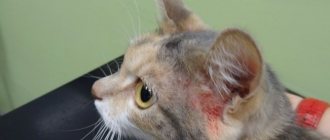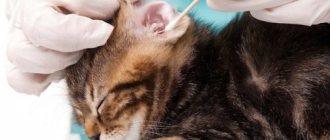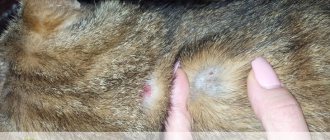The procedure for making a diagnosis for skin problems in a cat
The veterinarian begins the appointment from afar - asks the owner about the conditions of the pet’s keeping, about nutrition, about changes in behavior. Only after this the specialist examines the animal. First, the doctor assesses the general condition of the skin and coat and pays attention to the location of the problem. So, scratching near the ears of a cat may indicate that the problem lies inside the ear. Severe itching is caused by otodectosis - ear scabies.
If lichen is suspected, Wood's lamp diagnostics is used. The skin and fur are examined under ultraviolet light in a completely dark room. Some fungal colonies will glow bright green. Even if there is no glow, a dermatologist can take a culture for the fungus.
Deep skin scrapings and microscopy are needed to detect subcutaneous microscopic mites in sarcoptic mange. But again, a negative scraping is not a sufficient basis to exclude the diagnosis.
In general, diagnosis in dermatology is complicated precisely because most diagnoses are confirmed empirically - the response to therapy is assessed. Some external parasites can be seen upon careful examination - haietiella, lice-eaters, fleas. But most often it is not possible to detect fleas. 90% of the flea population does not live on an animal, but is found in the environment. Those fleas that are on a cat cleverly hide in the thick undercoat and are often swallowed by licking and biting.
The dermatologist usually tells you how to treat your cat's scratching, and then begins to rule out the causes of itching one by one, starting with the most obvious ones. And the first recommendation is always treatment for fleas and other external parasites for at least three months.
Features of the reaction
Signs of different types of allergies have similar manifestations. A pathological reaction to flea saliva can cause extensive damage to the croup, back and tail. Food allergies most often occur in the head and neck area. Periods of seasonal exacerbation are also possible. The phenomenon is most typical for atopic dermatitis.
It is important to find out in a timely manner why your cat scratches its neck a lot. Ulcers, open wounds and rashes can pose a serious threat to the health and life of a pet, acting as a source of secondary infection. Some members of the cat family are more prone to allergic reactions.
This fact is explained by heredity and the characteristics of the breed. Pronounced signs can manifest themselves against the background of insufficiency of the enzymatic system, congenital pathologies of the gastrointestinal tract, and unfavorable ecology of the habitat.
Scratch treatment
First of all, you need to remove the cause of itchy skin. Any veterinarian will tell you how to treat cats scratching on the neck and other areas of the body: you have to start with antiparasitic treatment. You should use modern means - they are effective and safe. You should not wash cats if you suspect a flea infestation - this is very stressful for cats, and bathing will not help get rid of parasites. If you wash off the natural fat layer from the skin, this will prevent the drops from being absorbed onto the withers, and it is the drops that most veterinarians prescribe for the treatment of parasitosis. It is painless for the cat and convenient for the owners.
Alcohol-based drops, such as Stronghold, are absorbed and evaporated very quickly - after just two hours you can stroke your cat’s fur. This is especially important if there are children in the house. "Stronghold" is convenient and has a wide weight range. If it is not possible to weigh your pet at a veterinary clinic, drops for cats weighing 2.6-7.5 kg are suitable for most adult animals.
After regular treatment with flea and tick drops, you can move on to further diagnostics, such as an elimination diet to detect food allergies.
Sometimes it takes a long time to conduct research and eliminate the problem, and you need to stop the painful process of itching as early as possible. Then antipruritic therapy is used.
Often owners are interested in what to anoint their cat’s scratches to speed up their healing. The choice of ointment depends on whether a secondary bacterial infection has developed after skin damage. You can use complex ointments with antipruritic, antifungal and antibacterial effects. But if the cat has scratches on its back, you will have to put a collar on the pet to prevent licking of the drug.
Omega-3 fatty acids, B vitamins (brewer's yeast) and trace elements such as sulfur and zinc contribute to skin healing. Fish oil, brewer's yeast or special vitamin-mineral complexes for skin and coat are added to the diet of natural-fed cats. If your cat eats commercial food, then it is enough to switch to a special diet to treat dermatitis.
Definition of pathology
The increased sensitivity of the animal's immune system to the effects of certain substances can identify agents that are harmless in nature as a pathogenic irritant. A pronounced reaction causes rejection mechanisms, provoking acute inflammatory processes.
A feature of allergies in animals is individual intolerance to various agents. Signs and severity of manifestations may vary depending on the characteristics of the pet’s body. You can find out why a cat scratches its neck by studying the symptoms of the disease:
- hyperemia, redness of the skin;
- severe itching (the animal scratches and scratches itself);
- discharge from the nasal passages;
- tearing eyes, otitis media;
- eczema;
- hair loss;
- rash, papules;
- Gastrointestinal upset (diarrhea, vomiting).
Purulent inflammation indicates the development of a secondary bacterial lesion. Allergies can occur even with a small amount of irritant affecting or entering the body.
Preventing skin problems in cats
Regular treatment for external and internal parasites is a prerequisite for the prevention of diseases in cats. In the warm season, it is especially important to protect your pet from fleas and ticks, and in some cases (warm climate, contact with stray animals, etc.) treatment should be year-round. You need to use safe products to which the cat is not allergic, and weigh the animals before treatment.
Healthy, well-groomed pets rarely become infected with fungal infections. Therefore, conditions of detention are important. In addition to protection from external parasites, the cat should regularly receive anthelmintic, be vaccinated in a timely manner, and for older animals an annual medical examination with blood tests is also relevant.
Balanced, nutritious feeding also helps maintain healthy skin and coat, regardless of whether you prefer natural food or commercial food. A healthy cat should have a “glossy” appearance and not suffer from year-round shedding, mats or dandruff.
Some diseases, such as autoimmune diseases or allergic reactions, cannot be predicted or prevented. In this case, the owner can do only one thing - promptly contact a specialist if the cat develops scratching or other skin problems.
Main Factors
The causes of acute manifestations of allergies, when a cat scratches its neck until it hurts, can be:
- Food;
- medicines;
- plants, pollen, mold;
- household chemicals;
- cigarette smoke;
- flea saliva (flea medications);
- environmental materials (fabrics, plastic, rubber).
Animals that have the opportunity to walk outdoors are more susceptible to developing reactions to flea bites and plant-derived agents. Even in the absence of obvious presence of insects, damage may occur upon contact with other animals. One flea bite is enough to cause intense itching for several weeks.
Substances and materials in the external environment can provoke severe atopic dermatitis with painful manifestations. The development mechanism most often occurs at the age of up to 3 years. The allergen is very difficult to identify and eliminate.
Various substances and objects from the external environment can be an irritating factor. It is impossible to completely isolate a pet from contact with agents. The pathological condition requires lifelong therapy. Regular use of medications will make your pet’s life easier, making it quite comfortable.
It's possible that when a cat scratches its neck until it bleeds, it may be due to a food allergy. Finding out which food product provokes the reaction is quite difficult. The development of pathology may not occur instantly, but over a long period of accumulation of the immune response to the agent. In the future, with subsequent consumption of the allergenic product, the reaction manifests itself quickly. Quite often it occurs on protein foods.
Infestation by exogenous insects
Both fleas and other bloodsuckers can parasitize a cat’s body . The presence of these insects leads to the occurrence of various diseases. The most dangerous of them include:
- flea dermatitis;
- mite damage: sarcoptic mange, notoedrosis.
When a flea bites, a wound with their saliva remains on the animal's body, causing severe itching. The cat begins to vigorously scratch the affected area, which leads to the infection getting inside. The inflammatory process in combed areas is manifested by redness and hair loss.
Fleas not only contribute to the occurrence of infectious diseases, but are also carriers of worm eggs (helminths).
When infected with ticks, the clinical picture in cats is as follows::
- severe itching on dry areas of the skin;
- hair loss;
- formation of ulcers on exposed areas.
Notoedrosis in cats is manifested by the presence of Notoedres cat mites and is accompanied by the following symptoms:
- itching and severe scratching;
- rash in the form of blisters;
- the appearance of crusts on itchy areas;
- hair loss;
- loss of skin elasticity, appearance of cracks infected with bacteria and fungi.
Sarcoptic mange occurs in cats due to their infestation with mites of the species Sarcoptes canis .
These tiny bloodsuckers are 0.2-0.4 mm long and have a long proboscis. Thanks to this, they easily gnaw holes in the skin and make a large number of moves in it. Once on the animal's body, the parasites begin to actively lay larvae. In this regard, already 1.5 months after their appearance, their numerous offspring are present on the cat’s body. The main symptom of this disease is severe itching, which gets worse in the evening. First of all, the tick infects areas on the animal’s head, neck, and near the ears, where blisters and redness immediately appear. After a while, these places become covered with dried crusts. The animal becomes restless, constantly itches and meows. Constantly scratching itchy areas, the cat cannot sleep, loses its appetite and experiences weight loss.
Therapy involves not only getting rid of bloodsuckers, but also healing damaged skin areas, as well as restoring the pet’s immune system.
Important! At the first signs of sarcoptic mange, the cat should be shown to a specialist.
Eczema
Eczema affects the top layer of skin, causing redness, a rash, and then oozing blisters. All this causes itching in animals and scratching of inflamed skin. In the event of a bacterial infection, sores appear on areas of the skin affected by eczema - flaky and filled with pus.
In dogs, eczema most often affects the lumbar region, but gradually affects larger areas of the skin. If the process involves deeper layers of skin, then we will talk about dermatitis.
There are many causes of eczema: these are both external and internal factors. Eczema can be caused by diseases of internal organs and endocrine disorders. Therefore, it is so important that a correct diagnosis is made and adequate treatment is prescribed.
After all, no ointments can rid your pet of this insidious disease until you normalize the functioning of its internal organs.
Infectious skin diseases
Skin diseases are the most common problems causing problems for cats and their owners.
Most often, this affects pets that occasionally walk outside. Diseases caused by bacterial infections occur in two forms , such as:
- dry, accompanied by the formation of dry scaly plates and crusts;
- wet, expressed in the appearance of ulcers and blisters filled with exudate.
Cats that have suffered serious illnesses, as well as surgical operations, remain immobile for some time, as a result of which they develop bedsores. Tissue necrosis occurs in areas of prolonged contact of the skin with the litter. To prevent this, the animal must be turned over as often as possible, and places where bedsores may form should be wiped with camphor alcohol or disinfectants.
Cats with hypersensitive skin are at risk of developing eczema . The reasons for its occurrence may be different:
- skin damage due to prolonged friction from contact with any object (collars, harnesses, etc.), due to burns and parasite bites;
- consequences of internal disorders in the body (neuropathy): hormonal imbalance, diabetes.
With eczema, the animal's skin develops rashes and blisters . There is a constant itching sensation in the affected areas (including the neck). To treat this disease, various ointments, soothing powders, and antibiotics are used.
A common disease among cats is acne (blackheads). Its cause may be the animal's low immunity, being under stress or improper care. This bacterial infection has a detrimental effect on the sebaceous glands. As a rule, its presence is indicated by rashes in the form of ulcers throughout the animal’s body. The largest accumulation of acne occurs on the cat's chin, neck and lip area.
At the beginning of treatment, the skin is first treated with antiseptic detergents.
Ringworm and other types of skin mycoses
The reason why a cat itches, but there are no fleas, may be various fungal skin infections. Dermatomycosis is a common and diverse pathology in cats. They are caused by molds and yeasts. In weakened animals and kittens, progressive mycosis can lead to death.
Dermatomycosis in cats is a poorly studied group of diseases. The most famous is trichophytosis or ringworm:
- When the disease occurs, areas with lost hair form;
- the pathology is accompanied by the formation of abundant dandruff and severe itching, in which the cat scratches the affected area until sores appear;
- Many types of mycosis are transmitted through the bites of blood-sucking insects.
A sick pet can infect its owner. Young children who, due to insufficiently developed immunity, lack protection against fungi are especially at risk.
Ringworm in cats
All types of cats are susceptible to skin fungal pathologies. But veterinarians note that Persians are especially prone to fungal infections.
If scratching or areas of hair loss, especially clearly limited ones, appear, you should consult a doctor, since only with the help of microscopy can you determine the type of pathogenic fungus and determine how to treat it.
Therapy for mycoses involves drugs from the griseofulvin group, vaccination and the use of external antifungal agents. Itching can be treated using symptomatic external remedies. A cat itches as long as there is an irritating factor - it will disappear and the pet will not itch.
Why you can't stop itching
If you have not yet visited the veterinarian, you should not smear the sores with anything at all - this will distort the results of scrapings and tests, which will complicate the diagnosis. You should not immediately offer your animal antihistamines - firstly, you may not guess the dosage, and secondly, the blood test will be invalid.
Once the veterinarian has prescribed medications and ointments, there is no need to relieve itching - most medications already contain substances that reduce discomfort.
Finally, anti-itch medications in humans can cause allergies in cats, which will only make the problem worse.
Bacterial or fungal inflammation
Various opportunistic microorganisms living on your pet's skin do not harm a healthy animal. But if your cat’s body has been weakened, for example, due to some disease or lack of vitamins, then the population of “harmful” fungi and bacteria increases, causing the cat’s skin condition and general well-being to deteriorate.
The doctor will check for inflammation caused by fungus or bacteria and also conduct a smear examination. As a rule, this inflammation is not the main cause of the disease.
What will the vet do?
If your cat is itching, it is best to show the animal to a veterinarian. Self-medication or ignoring alarming symptoms can cause the pathological condition to become chronic or cause severe consequences.
In a veterinary clinic, treatment of itching is carried out by identifying and eliminating the causes of its occurrence. To do this, tests are taken from the animal to determine the main etiological factor in the development of the disease. Next, the necessary treatment is prescribed, this can be either drug therapy or the selection of the necessary diet.
The cat itches, chews itself, constantly licks itself: is this normal?
If an animal itches due to severe itching, then with sharp claws it damages the skin, causing infection.
During severe itching, severe irritation of pain receptors occurs, because of this the animal begins to lick and chew itself. The skin on the affected area turns red and wounds appear. The reasons for this condition are different. To relieve the symptom and understand what to do, the pet must be shown to a doctor.
When it's ok
Cats are clean creatures. They wash themselves after sleep and after eating. If your pet eats natural food, then after licking the fur it will smell like the food it ate.
The smell of eaten herring is especially strong. If the animal licks itself too much, then it needs a medical examination.
Signs of a pathological condition of an animal
The painful condition can be determined by itching of the skin or ears. With skin itching, you can notice how the cat itches a lot and tries to bite the source of its anxiety from under the skin with its teeth.
When the itching is localized in the ear, the cat tries to stick its paw deep into it to scratch.
During this period you may notice:
- constant scratching of the body with a plaintive meow;
- pronounced biting of the skin;
- hair loss, deterioration of its appearance;
- the appearance of dandruff, oily scales;
- the skin is covered with ulcers or red rashes in the form of small spots;
- parasites or their excrement are visible on the skin.
It is easy to help an animal if you notice deviations in behavior in time and take him to the clinic. An advanced disease is more difficult to cure.
What to do if treatment is unsuccessful?
With correctly prescribed therapy, the effect is noticeable from the first days: the animal itches less and the ulcers begin to dry out. If there is no improvement within 5-7 days, you should definitely visit a veterinary clinic.
Even if the veterinarian prescribed the drugs, but there is no result, contact us again. It also happens that an examination by another doctor or in another veterinary clinic helps.
The main thing is not to let things take their course and achieve improvements in the cat’s condition. Otherwise, you will have to treat not only the root cause, but also secondary infections.
Allergies as a cause of itching and scratching
If all of the above reasons are excluded, the doctor will assume an allergy.
Food allergies
If you're lucky, the allergy will be food, that is, caused by eating foods or feed that are not entirely suitable for the cat. Food allergies are identified by taking a detailed history. It is important to remember what you fed your ward for the last 10 days, did you change the food, did you treat it from the table, etc. To alleviate the condition, the animal is transferred to a neutral diet and supported with antihistamines. How to recognize allergies in the video below:
Gradually, the cat’s diet begins to expand by one product at a time and the reaction is monitored. Many purebred cats are allergic even to different types of meat. Recently, allergies to store-bought chicken meat have become very common, apparently due to the solutions used to treat carcasses. Eliminating food allergies will take time; the quickest option is to switch the animal to high-quality hypoallergenic food.
Non-food allergies
Non-food allergies are much more troublesome, since the pet’s reaction can be associated with any object in the home. First of all, bowls and bedding are changed. By the way, if you recently washed your cat’s bed, the cause of the allergy may be in the detergent. The cat is not bathed with shampoos and is kept in as neutral an environment as possible. During all preparations, the animal is prescribed antihistamines.
Important! Determining the type of allergy a cat has through testing is not entirely relevant. When an animal is already scratching, the immune system is very stressed, which can give false positive results.
Non-food allergies can be seasonal, for example, during the flowering of grass, a cat may develop a reaction to spores and pollen, in dry weather - to dust, etc. In this case, the animal’s condition will be alleviated only with antihistamines. Sometimes, the reaction is partially controlled by diet, since it relieves the general stress of the immune system.
Important! Atopic dermatitis is another type of allergy whose causes cannot be determined. It is believed that atopy occurs against the background of a combination of causes - dust, spores, pollen and other microparticles concentrated in the home.
If the veterinarian is unable to identify the cause of the allergy, the animal is given gentle therapy, which is carried out in courses and helps combat itching. Not the best, but sometimes the only option to improve the quality of life of the ward. The cat's condition must be constantly monitored, since atopy occurs for unknown reasons and can also disappear suddenly.
Advice: if a prompt appointment with a veterinarian is not possible, you need to treat the cat’s scratching with Levomikol, and you can use children’s Diazolin or Suprastin to relieve itching.
Itching caused by helminths
Helminths in cats
Helminths not only have a pathological effect on the cat’s digestion. Worms cause loss of essential nutrients by absorbing micronutrients from the intestines. As a result of lack of nutrition, the pet's skin becomes dry, dandruff appears, and the cat licks itself much more often and more intensely, trying to get rid of the itching.
Intoxication of the animal's body with waste products and toxins produced by worms provokes an allergic reaction, skin rashes, and itching. Even a tiny kitten can suffer from helminthiasis after acquiring parasites from an adult cat. Therefore, if the kitten is itching, it is necessary to check its feces for the presence of worm eggs. The area around the anus may also itch when helminths crawl out to lay eggs. The cat then behaves characteristically - it “rides” on the carpets with its butt, relieving the itching.
Interesting!
There are 3 types of helminths parasitizing the body of cats:
- roundworms;
- tapeworms;
- flukes.
Some species are transmitted through flea bites to humans. The presence of worms in kittens leads to delayed growth and development, and in pregnant cats, worm infestation can cause miscarriage. In the presence of individual individuals in the body, the disease can be asymptomatic. Fleas also transmit helminthiasis to other pets, so all inhabitants of the house need to be treated.
Medicines for helminths
If the itching is caused by worms, then it is necessary to deworm the animal. For this purpose, as prescribed by the veterinarian, the animal is given Prasitel, Pyrantel, Trontsil K, Kanikvantel, Profender, Polyvercan (sugar cubes), Panacur, Febtal, Dirofen, Milbemax, Drontal. But first you should undergo an examination and determine the type of parasite, since broad-spectrum drugs are much more toxic than those that act selectively.
Lichen
This disease, which has many varieties, is caused by fungi of the Microsporum, Trichophiton or Epidermophiton species and affects the skin and hair follicles - and not only pets, but also humans. Here are the most common and dangerous types: pityriasis, red flat, pink and ringworm.
The clinical picture in case of lichen infection is as follows: skin lesions with rounded shapes or with uneven edges, accompanied by redness, itching, hair loss and peeling, occurring more often in the head, neck and extremities.
Without properly prescribed treatment, lichen spreads to other parts of the pet's body, and the affected skin can become inflamed and fester, and as a result, sores appear on it - this is due to a bacterial infection.
Only a correct diagnosis will help cure the animal and prevent serious complications.











